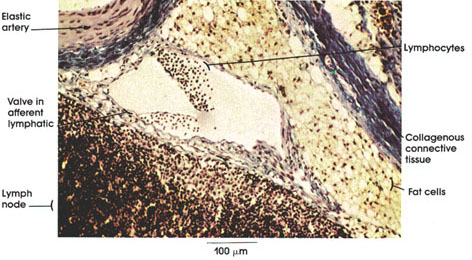

Ronald A. Bergman, Ph.D., Adel K. Afifi, M.D., Paul M. Heidger,
Jr., Ph.D.
Peer Review Status: Externally Peer Reviewed

Rat, Helly's fluid, Mallory's stain, 162 x.
This plate shows an afferent lymphatic vessel near a lymph node. The lymph vessel is lined with endothelium and has a valve that opens toward the node. The valve is a fold of that part of the vessel wall known as the intima (Plates 152 and 161). Valves, by preventing retrograde flow, are essential for the movement of lymph to major lymphatic trunks. Lymph is formed in part from materials and fluid that leave the capillaries and venules of the blood vascular system. This extracellular fluid contains small molecular weight substances, neutral fat, protein, and metabolic products from cells that enter lymphatic capillaries and are carried by a system of lymphatic vessels to and from lymph nodes to the thoracic duct and other lymph vessels to empty into the blood vascular system. Lymphatic vessels also have a primary role in the transport of absorbed fats and fat-soluble substances from the digestive tract. The total volume of lymph carried by lymphatic vessels that passes into the blood is estimated to be about 1.5 to 2.2 liters per day.
Collagenous connective tissue forming the capsule of the lymph node, as well as fat cells and an artery, is seen adjacent to the afferent lymph vessel.
Lymphatic vessels and the fluid they carry (lymph) were discovered in 1627 by Gasparo Aselli, Professor of Anatomy at the University of Pavia.
Next Page | Previous Page | Section Top | Title Page
Please send us comments by filling out our Comment Form.
All contents copyright © 1995-2025 the Author(s) and Michael P. D'Alessandro, M.D. All rights reserved.
"Anatomy Atlases", the Anatomy Atlases logo, and "A digital library of anatomy information" are all Trademarks of Michael P. D'Alessandro, M.D.
Anatomy Atlases is funded in whole by Michael P. D'Alessandro, M.D. Advertising is not accepted.
Your personal information remains confidential and is not sold, leased, or given to any third party be they reliable or not.
The information contained in Anatomy Atlases is not a substitute for the medical care and advice of your physician. There may be variations in treatment that your physician may recommend based on individual facts and circumstances.
URL: http://www.anatomyatlases.org/